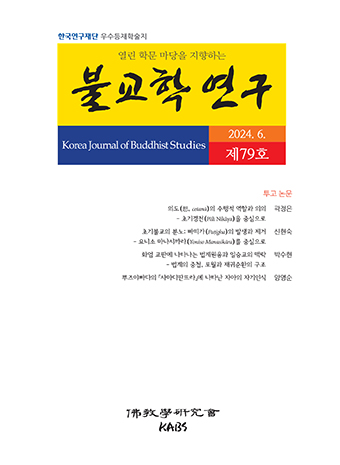Abstract
References
Sorry, not available.
Click the PDF button.
Information
Shi Daoan (釋道安) of the Northern Zhou (北周) Dynasty, recorded in the Sequel to the Biographies of Eminent Monks (續高僧傳), is the teacher of Huiying (慧影) who composed the extant Commentary on the Dazhidulun (大智度論疏). Shi Daoan is said to have preached on the Dharma solely upon the basis of the Nirvana Sutra and the Mahā-prajñāpāramitā-śāstra. The Exposition of the Dazhidulun (大智度論解) composed of 24 fascicles, possibly written by him, is not extant; even the Commentary on the Dazhidulun is being transmitted partially now. The “master’s words (師言)” or the “master’s understanding (師解),” appearing frequently in the Commentary, might be regarded as Daoan’s exposition on the Dazhidulun (大智度論). This article purports to analyze these expressions by the “master,” in order to investigate the commentarial traits of the Mahā-prajñāpāramitā-śāstra Masters from Northern Dynasties. As it can be surmised by the record that he revered the Nirvana Sutra, there are numerous citations of the sutra in the work. Now, the following traits could be clarified in the citations of the Nirvana Sutra. First, there are direct applications of the Nirvana Sutra in the commentarial inter-pretation of the Prajñāpāramitā-madhyamaka texts. Second, while the Mahā- prajñāpāramitā-śāstra Masters (智度論師)’ arguments are different from those of the Nirvana Sutra in some aspects, there are citations of the Nirvana Sutra in the complementary context for understanding the Mahā-prajñāpāramitā-śāstra. In the analysis of the “master’s words (師言)” or his opinions, there appear such explanations on the basis of Prajñāpāramitā doctrines as to argue from the Prajñāpāramitā-madhyamaka perspective. On the other hand, however, the “master’s understanding (師解)” reveals conspicuous emphasis on the combination of prajñā and ālaya-vijñāna (阿梨耶識) apprehended in the context of the tatāgatagarbha and the Dilun (地論) doctrines. The prajñā of true reality (實相般若) appears to be explained as the pure innate mind (自性淸淨心), while ālaya-vijñāna (阿梨耶識) appears to be understood as the true wisdom [眞智=眞證智慧] of the pure innate mind.
속고승전(續高僧傳)에 기술되어 있는 북주(北周)의 석도안(釋道安)은 현전하는 대지도론소(大智度論疏)를 찬술한 혜영(慧影)의 스승이다. 도안은 열반경과 대지도론만을 가지고 법을 펼쳤다고 전한다. 그가 찬술했을 가능성이 있는 지도론해(智度論解)24권은 전하지 않고, 대지도론소24권도 부분적으로만 전하고 있다. 본소에는 도안이 특히 열반경을 숭상하였다는 기록에서 알 수 있듯이 열반경 인용이 많다. 그래서 열반경을 분석한 결과 다음과 같은 인용 특징을 밝혔다. 첫째, 반야중관계 문헌을 주석하는데 직접 열반경을 대입하여 해석한다. 예를 들면 반야경과 대지도론에서의 법성(法性)은 열반경의 불성(佛性)과 동격이 됨을 상세하게 주석한다. 둘째, 지도론사의 주장이 열반경과 다른 측면을 드러내기도 하지만, 대지도론 이해를 위한 보완적 의미에서 열반경을 인용한다. 기본적으로는 열반경을 중시하는 입장이 강하게 보인다. 본 논소 가운데 많이 기술된 스승의 말[師言], 스승의 견해[師解]는 거의 도안의 대지도론 주석이라고 보아도 좋다. 그러나 한편으로 이것은 도안으로 대표되는 구마라집 이래의 지도론사들의 전승적인 주석이라고 생각할 수 있다. 그래서 이것을 그대로 사언(師言), 사해(師解)로 두고 분석하였다. 사언과 사해의 문장을 분석한 결과, 반야중관적 입장에서 ‘색즉시공공즉시색’을 상즉(相卽)이라고 설명하면서 성실사(成實師)의 즉시설(卽是說)과는 다르다고 하는 것처럼, 반야사상에 입각한 설명이 보이기도 한다. 그러나 한편으로 여래장 계통의 사상과 지론사상에 의해 습득된 아리야식(阿梨耶識)을 반야와 결합하는 내용이 많이 보인다. 실상반야(實相般若)를 자성청정심(自性淸淨心)이라고 하고, 아리야식을 자성청정심의 참된 지혜[眞智]로 이해하고 있음을 드러낸다. 이것은 열반사(涅般師), 지론사(地論師), 삼론가(三論家)와 같은 당시의 여러 논사들과 다른 지도론사의 독창적인 경향이다.
Click the PDF button.
- Publisher :Korean Association of Buddhist Studies
- Publisher(Ko) :불교학연구회
- Journal Title :Korea Journal of Buddhist Studies
- Journal Title(Ko) :불교학연구
- Volume : 49
- No :0
- Pages :141~167


 Korea Journal of Buddhist Studies
Korea Journal of Buddhist Studies






